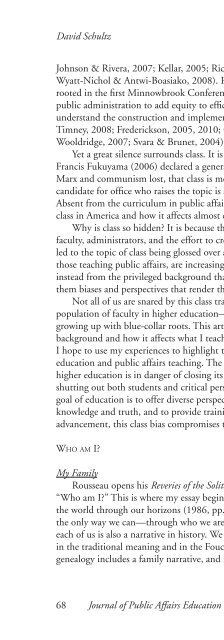WINTER 2012 - National Association of Schools of Public Affairs and ...
WINTER 2012 - National Association of Schools of Public Affairs and ...
WINTER 2012 - National Association of Schools of Public Affairs and ...
Create successful ePaper yourself
Turn your PDF publications into a flip-book with our unique Google optimized e-Paper software.
Bin Chen, Feng Wang <strong>and</strong> Jianmin Song<br />
The first part <strong>of</strong> conceptualization refers to the resources embedded in<br />
structures <strong>of</strong> social relations (Lin, 2000). The second part emphasizes positions<br />
in a network or network characteristics. It is generally believed that social<br />
capital enhances the likelihood <strong>of</strong> instrumental returns, such as better jobs,<br />
earlier promotions, higher earnings or bonuses, <strong>and</strong> expressive returns, such as<br />
friendship <strong>and</strong> emotional support.<br />
Since social capital is developed through networking, students can increase<br />
their personal contacts through pr<strong>of</strong>essional graduate studies. Development<br />
<strong>of</strong> social capital via participation in academic <strong>and</strong> social activities is generally<br />
encouraged by pr<strong>of</strong>essional degree programs. The cohort <strong>of</strong> a specific class,<br />
the full alumni <strong>of</strong> the university, <strong>and</strong> the overall population <strong>of</strong> graduates serve<br />
as a foundation stone for networking. Being part <strong>of</strong> these networks is a great<br />
asset for individual students. This is especially important in China, given the<br />
prominent role <strong>of</strong> relationships. As a society <strong>of</strong> acquaintances, Chinese civil<br />
servants have long been known for their use <strong>of</strong> guanxi (“connections”) for career<br />
development. In ancient China, those who passed civil servant examinations<br />
found it judicious to maintain close ties with their peers. Persons from the same<br />
examination district or those who passed the examinations in the same year<br />
always felt a fraternal bond among themselves. The successful c<strong>and</strong>idates, as a<br />
group, honored their examiners as lifetime mentors. They established their own<br />
lines <strong>of</strong> communication <strong>and</strong> formed their own informal networks outside formal,<br />
hierarchical bureaucratic structures (Huang, 1981).<br />
One <strong>of</strong> the insights from organizational research is that effective managers<br />
go outside the formal chain <strong>of</strong> comm<strong>and</strong> to develop cooperative relationships<br />
with others (peers, superiors, outsiders, suppliers, customers, etc.). They rely<br />
on networks <strong>of</strong> relations for the resources, information, <strong>and</strong> support needed<br />
for career success (Coleman, 1988; Lin, 1999; Seibert, Kraimer, & Liden,<br />
2001). They recognize that the larger their network, the greater their chance for<br />
successfully carrying out their vision <strong>and</strong> the goals <strong>and</strong> objectives that support it.<br />
They nurture these relationships by doing favors for others, encourage people to<br />
identify with their goals <strong>and</strong> vision, <strong>and</strong> seek to develop a feeling <strong>of</strong> dependence.<br />
Successful network managers ensure that all <strong>of</strong> their goals <strong>and</strong> objectives<br />
receive attention <strong>and</strong> select the right networks to get the results they desire.<br />
Multiple agendas require multiple action networks, <strong>and</strong> the effective manager<br />
is managing his or her influence networks simultaneously (Kotter, 1982).<br />
Empirical studies confirmed the benefits <strong>of</strong> teaching executives to underst<strong>and</strong> the<br />
network structure <strong>of</strong> social capital. Burt <strong>and</strong> Ronchi (2007) found that business<br />
executives trained in the network structure <strong>of</strong> social capital showed performance<br />
improvement relative to a control group <strong>of</strong> untrained <strong>and</strong> yet equally capable<br />
peers. By comparing managerial strategies <strong>of</strong> superintendents in Texas school<br />
districts, Meier <strong>and</strong> O’Toole (2001) discovered that networking activities <strong>and</strong><br />
behavior enabled public managers to more effectively attract <strong>and</strong> utilize resources<br />
<strong>and</strong> contributed substantially to the student outcomes.<br />
140 Journal <strong>of</strong> <strong>Public</strong> <strong>Affairs</strong> Education

















